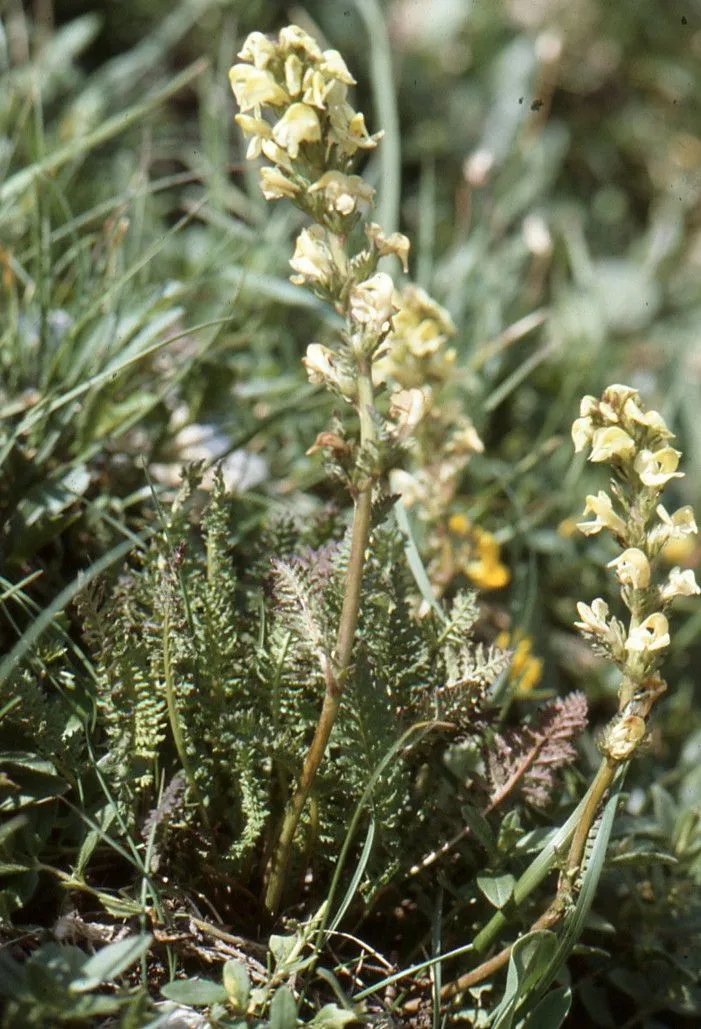
Author: L.
Bibliography: Sp. Pl.: 600 (1753)
Year: 1753
Status: accepted
Rank: species
Genus: Pedicularis
Vegetable: False
Observations: SC. France to S. Bulgaria and S. Italy
Crested lousewort (Pedicularis comosa) is a captivating and unique perennial herb that attracts both botanists and plant enthusiasts alike. This intriguing plant, first documented in the seminal work “Species Plantarum” in 1753 by the famous botanist Carl Linnaeus (commonly abbreviated as L.), is part of the Orobanchaceae family.
Native to select regions within Europe, the crested lousewort can be observed flourishing from southeastern France to southern Bulgaria and throughout southern Italy. This geographical range highlights the plant’s adaptability to various microenvironments within these southern locales.
The crested lousewort is particularly notable for its striking inflorescence. It produces dense, crest-like clusters of flowers, which have contributed to its common name. These blossoms not only add to the aesthetic value of the regions where they are found but also play a role in local ecosystems by providing resources for various pollinators.
Growing in diverse habitats, the crested lousewort often favors meadows and grasslands where it can access the optimal balance of sunlight and moisture. It is known for its semi-parasitic nature, deriving some of its nutrients from neighboring plants’ roots through specialized structures called haustoria. Despite its parasitic tendencies, it coexists relatively harmoniously within its environment.
This plant is distinguished by its tall, slender stems that support the vibrant flower clusters, creating a visual spectacle during its blooming season. The lanceolate leaves are intricately lobed, adding an extra layer of texture and complexity to its overall appearance.
Beyond its visual and ecological attributes, crested lousewort also holds a place in botanical research and cultivation. Its unique characteristics make it a subject of interest in studies related to plant parasitism and symbiosis, as well as in the broader context of biodiversity and conservation in the European flora.
In conclusion, the crested lousewort (Pedicularis comosa) is a remarkable species that stands out due to its distinctive floral structures and its role within the ecosystems of southern Europe. Its presence from southeastern France to southern Bulgaria and southern Italy adds charm and biological interest to these regions, making it a plant of significant scientific and aesthetic value.
Swe: kvarnspira
En: Crested lousewort, Tufted lousewort
Fr: Pédiculaire chevelue
De: Schopfiges Läusekraut, Schopfiges Läuserkraut
It: Pedicolare chiomosa
Sv: Kvarnspira
Taken Jul 3, 1994 by Tela Botanica − Liliane ROUBAUDI (cc-by-sa)
Taken Jul 3, 1994 by Tela Botanica − Liliane ROUBAUDI (cc-by-sa)
Taken Jun 14, 2021 by Alain Bigou (cc-by-sa)
Taken Jul 9, 1995 by Tela Botanica − Liliane ROUBAUDI (cc-by-sa)
Taken Jul 3, 1994 by Tela Botanica − Liliane ROUBAUDI (cc-by-sa)
Taken May 29, 2021 by Bernard Fabre (cc-by-sa)
Taken Jul 21, 1987 by Tela Botanica − Liliane ROUBAUDI (cc-by-sa)
Taken Jul 9, 1995 by Tela Botanica − Liliane ROUBAUDI (cc-by-sa)
Taken Jun 14, 2021 by Alain Bigou (cc-by-sa)
Taken Jul 3, 1994 by Tela Botanica − Liliane ROUBAUDI (cc-by-sa)
Taken Jun 20, 2000 by Tela Botanica − Liliane ROUBAUDI (cc-by-sa)
Taken Jun 14, 2021 by Alain Bigou (cc-by-sa)
Taken Jun 14, 2021 by Alain Bigou (cc-by-sa)
Taken May 31, 2020 by Ivana Vidov Anić (cc-by-sa)
Taken May 29, 2021 by Vincent Bayot (cc-by-sa)
Taken Jun 19, 2019 by MICHEL DUSSERE (cc-by-sa)
Taken Jan 1, 1970 by Photoflora – L’Abbé COSTE (©)
Taken May 15, 2008 by Photoflora – Benoit BOCK (©)
© copyright of the Board of Trustees of the Royal Botanic Gardens, Kew.
© copyright of the Board of Trustees of the Royal Botanic Gardens, Kew.
© copyright of the Board of Trustees of the Royal Botanic Gardens, Kew.
Ph maximum: 4.5
Ph minimum: 4.0
Light: 8
Atmospheric humidity: 5
Soil nutriments: 2
Family: Myrtaceae Author: (F.Muell.) K.D.Hill & L.A.S.Johnson Bibliography: Telopea 6: 402 (1995) Year: 1995 Status:…
Family: Rubiaceae Author: Pierre ex A.Froehner Bibliography: Notizbl. Bot. Gart. Berlin-Dahlem 1: 237 (1897) Year:…
Family: Sapindaceae Author: Koidz. Bibliography: J. Coll. Sci. Imp. Univ. Tokyo 32(1): 38 (1911) Year:…
Family: Asteraceae Author: A.Gray Bibliography: Pacif. Railr. Rep.: 107 (1857) Year: 1857 Status: accepted Rank:…
Family: Fabaceae Author: Medik. Bibliography: Vorles. Churpfälz. Phys.-Ökon. Ges. 2: 398 (1787) Year: 1787 Status:…
Family: Aspleniaceae Author: (Cav.) Alston Bibliography: Bull. Misc. Inform. Kew 1932: 309 (1932) Year: 1932…